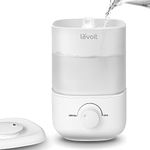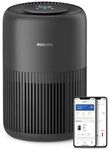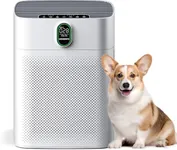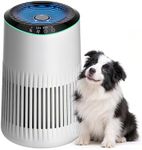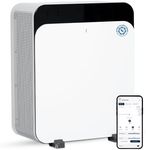Buying Guide for the Best Humidifier Air Purifiers
When choosing a humidifier-air purifier combo, it's important to consider both the humidification and air purification needs of your space. These devices are designed to improve indoor air quality by adding moisture to the air and removing pollutants, allergens, and other harmful particles. The right model for you will depend on the size of the area you want to treat, your specific air quality concerns, and any additional features you might find beneficial. Understanding the key specifications will help you make an informed decision that best suits your environment and health needs.Coverage AreaCoverage area refers to the maximum space size that the humidifier-air purifier can effectively serve. This is important because using a device that is too small for your room will not provide the desired air quality improvements. Coverage is usually measured in square feet. Small units are suitable for bedrooms or small offices, medium units for living rooms or larger offices, and large units for open-plan spaces or entire floors. To choose the right one, measure the area of the room you intend to use it in and select a model that can cover at least that size.
Filtration SystemThe filtration system is crucial for the air purification aspect of the device. It determines how effectively the unit can remove pollutants from the air. Common types include HEPA filters, activated carbon filters, and UV light. HEPA filters are excellent for capturing small particles like dust and pollen, activated carbon filters are good for odors and gases, and UV light can help kill bacteria and viruses. Consider your specific air quality concerns—such as allergies, pet dander, or smoke—and choose a filtration system that addresses those needs.
Humidification CapacityHumidification capacity indicates how much moisture the device can add to the air, usually measured in gallons per day. This is important for maintaining a comfortable humidity level, especially in dry climates or during winter. Low capacity units are suitable for small rooms, while higher capacity units are needed for larger spaces. Consider the climate you live in and the size of the room to determine the appropriate humidification capacity. If you experience dry skin or respiratory issues, a higher capacity might be beneficial.
Noise LevelNoise level is an important consideration, especially if you plan to use the device in a bedroom or office. It is usually measured in decibels (dB). Lower noise levels are preferable for quiet environments. Devices with a noise level below 30 dB are considered very quiet, suitable for bedrooms, while those between 30-50 dB are moderate and can be used in living areas. If noise is a concern for you, look for models that offer a 'quiet' or 'sleep' mode.
Maintenance RequirementsMaintenance requirements refer to how often you need to clean or replace parts of the device, such as filters or water tanks. This is important for ensuring the device continues to operate effectively and efficiently. Some models have washable filters, while others require regular replacement. Consider how much time and effort you are willing to invest in maintenance. If you prefer low-maintenance options, look for models with longer-lasting filters or self-cleaning features.
Additional FeaturesAdditional features can enhance the usability and effectiveness of the device. These might include smart connectivity, air quality sensors, automatic shut-off, or adjustable fan speeds. Smart connectivity allows you to control the device remotely via an app, while air quality sensors can adjust the device's operation based on real-time air quality. Consider which features are important to you and how they might improve your experience with the device. If you value convenience, look for models with more automation and smart features.





